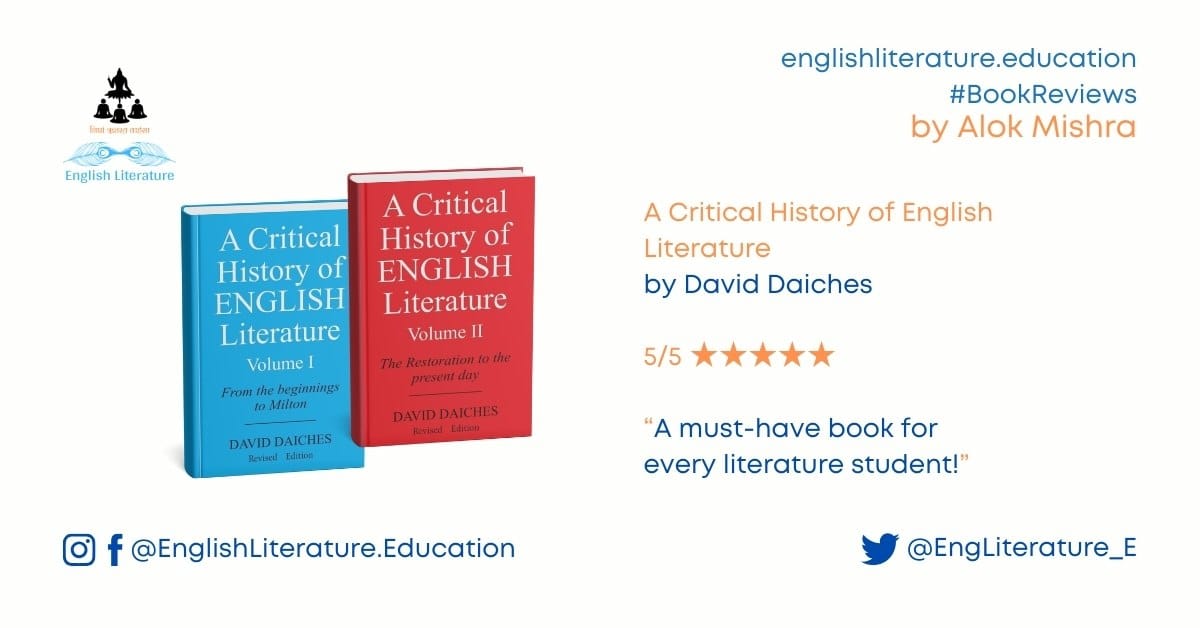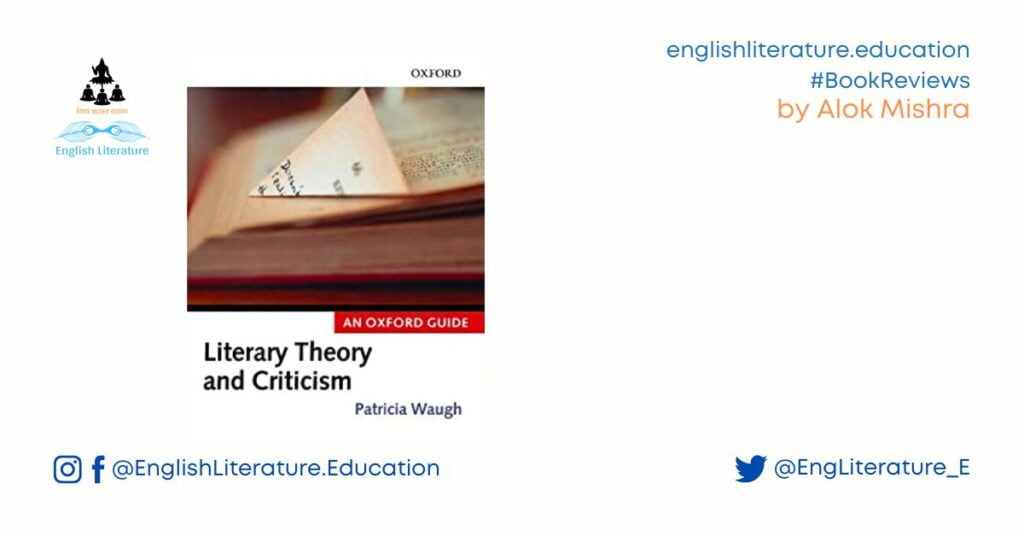David Daiches’ A Critical History of English Literature (published in two volumes) stands as one of the most ambitious and comprehensive surveys of English literary history. First published in 1960, Daiches’ work remains a significant reference for students and scholars alike, offering not just a chronological account but a deeply analytical and interpretative engagement with the evolution of English literature from its earliest forms to the mid-20th century.
David Daiches, a distinguished literary critic and historian, brings a formidable command of both historical context and critical theory to this work. His approach is neither purely encyclopedic nor narrowly specialised; instead, he strikes a balance between broad historical narrative and close textual analysis. The result is a work that is as readable as it is scholarly—a rare feat in literary historiography.
Recommended by one of my professors during my first year of studying English Literature, this book, in two volumes, has been one of my primary sources, along with Legouis and Cazamian’s book and Boris Ford’s. In this review, I will share my thoughts on the strengths and limitations of this excellent book. To begin with, it is totally worth having on your study table if you are serious about learning the history of English literature!
Get a copy from Amazon India – click here.
This review will assess the strengths and limitations of Daiches’ magnum opus, focusing on its writing style, analytical depth, structural organisation, practicality for students, and overall contribution to literary studies.
Writing Style: Clarity, Accessibility, and Engagement
One of the most striking features of Daiches’ work is his lucid and engaging prose. Unlike many literary histories that either drown in dry academic jargon or oversimplify complex ideas, Daiches strikes a balance between scholarly and conversational tones. He explicitly states in the preface that he intends the book to be “not merely a work of reference to be looked up, but to be read”—a goal he largely achieves. When needed, his explanations are comprehensive yet lucid, a significant marker of readability in today’s attention-span-limited era. Therefore, even modern students of literature can conveniently study this book without feeling overwhelmed, bored, or daunted, to be frank.
His decision to modernise spelling and punctuation in Middle English quotations (while retaining original phrasing) is a thoughtful touch that enhances accessibility without sacrificing authenticity. Moreover, his inclusion of liberal quotations from primary texts ensures that readers encounter the literature directly, rather than through a purely secondary lens.
Daiches’ writing is particularly effective when he synthesises broad literary movements with precise examples. For instance, his discussion of Chaucer does not merely list The Canterbury Tales as a milestone; instead, he analyses how Chaucer’s use of vernacular and narrative structure marked a turning point in English literature. Similarly, his treatment of Shakespeare avoids the usual platitudes about universal genius, instead focusing on how Shakespeare’s theatrical pragmatism and linguistic innovation shaped his work.
However, some readers might find Daiches’ prose occasionally dense, particularly in sections dealing with more obscure or philosophically complex writers (such as his analysis of T.S. Eliot’s “objective correlative”). While his style is generally straightforward, undergraduates or casual readers may need supplementary materials to grasp some of his more intricate arguments fully. And to be honest, that is what this book’s ideal goal should have been, from an academic perspective: to inspire students to read as much as they can and understand complex literary concepts before putting their pens to paper.
Analytical Approach: Critical, Contextual, and Comparative
Daiches does not merely catalogue literary works; he interprets and critiques them within their historical and cultural frameworks. His subtitle—A Critical History—is apt, for he consistently engages with literature as an evolving art form shaped by social, political, and intellectual currents.
1. Historical Contextualisation
Daiches excels at situating authors within their eras. His chapter on Christopher Marlowe, for example, does not treat Tamburlaine and Doctor Faustus as isolated masterpieces but as products of a Renaissance fascination with human ambition and existential limits. He contrasts Marlowe’s bombastic protagonists with Shakespeare’s more psychologically nuanced characters, illustrating how each dramatist responded to Elizabethan theatrical conventions.
Similarly, his analysis of Restoration comedy ties the genre’s wit and sexual frankness to the post-Puritan cultural backlash, showing how literature both reflects and reacts against its milieu. He does the same with leading literary figures from many different ages. The Romantic Poetry revolution in the context of the French Revolution and the literature of the modern era, as well as Eliot and Shaw, Pound and Woolf, in light of World War I. Historical contextualisation should help readers understand literature, including its possible inspirational sources, the human psyche of that era, and everything else happening around what was being written and read.
2. Comparative Criticism
Daiches frequently employs comparative analysis, weighing authors against their contemporaries and successors. His discussion of Romantic poetry does not treat Wordsworth, Coleridge, Byron, Shelley, and Keats as isolated figures but as participants in a broader aesthetic and philosophical movement. He highlights Wordsworth’s lyrical naturalism against Shelley’s visionary idealism, demonstrating how divergent strains of Romanticism coexisted.
His treatment of modernist poets, particularly Eliot and Pound, is similarly nuanced. He traces Eliot’s disillusioned fragmentation in The Waste Land back to the metaphysical wit of Donne, while also acknowledging the influence of French Symbolism. This layered approach prevents reductive categorisations and enriches the reader’s understanding of literary lineage.
3. Strengths and Limitations of Daiches’ Criticism
While Daiches’ analytical depth is impressive, some critiques can be made:
Canonical Bias: Like many mid-20th-century critics, Daiches places a heavy emphasis on the traditional canon, including Shakespeare, Milton, Wordsworth, and Eliot. Women writers and marginalised voices—such as Aphra Behn, Mary Wollstonecraft, or even later modernists like Virginia Woolf—receive comparatively scant attention.
Theoretical Constraints: Daiches writes before the rise of poststructuralism, feminist criticism, and postcolonial theory, so his readings sometimes lack the ideological scrutiny that later critics would apply. His analysis of colonial themes in Defoe or Kipling, for instance, remains primarily aesthetic rather than political.
Despite these limitations, his criticism remains foundational—a springboard for deeper inquiry rather than a final word.
Structural Organisation: Chronological Coherence
The two volumes are chronologically arranged, a logical choice for a literary history. Volume I covers Old English to the 18th century, while Volume II spans Romanticism to the mid-20th century. Each significant period is subdivided into genres and movements, allowing for both macro and micro perspectives.
Strengths of the Structure
Clear Progression: The narrative flows smoothly from medieval alliterative verse to Chaucerian narrative, Renaissance drama, Metaphysical poetry, Augustan satire, and beyond.
Thematic Continuity: Daiches avoids treating periods as isolated blocks. His chapter on the novel’s rise in the 18th century, for example, connects Defoe’s realism to Fielding’s picaresque humour and Richardson’s epistolary psychology.
Potential Drawbacks
Density of Detail: The sheer volume of material can be overwhelming. A chapter on “The Age of Johnson” might segue rapidly from Boswell’s biographies to Gothic fiction, risking information overload.
Uneven Coverage: Some sections, like Shakespeare and the Romantics, are richly detailed, while others, such as Victorian novelists beyond Dickens and George Eliot, feel abbreviated.
Still, the structure serves its purpose well, offering a balanced overview while allowing deeper dives where necessary.
Practicality and Usability for Students
Why This Book Remains Valuable
Comprehensive Scope: Few single-author surveys cover Beowulf to Beckett with such consistency.
Primary Text Integration: The liberal use of quotations allows students to engage directly with sources.
Critical Models: Daiches’ analyses demonstrate how to read literature critically, making the book useful for essay-writing and exam preparation.
Challenges for Modern Readers
No Illustrations: Unlike some contemporary literary histories (e.g., The Norton Anthology companion guides), Daiches’ text is purely textual, which may deter visual learners.
Dated Perspectives: While his critiques of Eliot or Joyce remain insightful, his lack of engagement with postcolonial, gender, or race studies may require supplementary readings.
Nevertheless, as a core reference, it remains indispensable.
Final Assessment: A Foundational Yet Flawed Masterpiece
David Daiches’ A Critical History of English Literature is a monumental achievement—a work of immense erudition, analytical sharpness, and narrative fluency. It succeeds in being both a reference guide and a critical companion, offering not just facts but interpretive frameworks.
Strengths
✔ Clear, engaging prose that avoids dryness
✔ Strong historical contextualisation of literary movements
✔ Effective use of comparative analysis (e.g., Marlowe vs. Shakespeare)
✔ Liberal quotations from primary texts enhance engagement
Limitations
✖ Canon-heavy, with less attention to women and minority writers
✖ Lacks modern theoretical lenses (feminist, postcolonial, etc.)
✖ Some sections feel rushed compared to others
Who Should Read It?
Undergraduates seeking a comprehensive literary overview
Graduate students needing a critical foundation for further research
General readers interested in a scholarly yet readable history
Conclusion
While later critics have expanded and challenged aspects of Daiches’ work, his Critical History remains a cornerstone of English literary studies. It is not without flaws, but its depth, clarity, and critical acumen ensure its enduring relevance. For anyone serious about understanding the sweep of English literature, Daiches’ two-volume opus is an essential—and highly rewarding—read.
Rating: ★★★★☆ (4.5/5)
(A near-masterpiece, slightly marred by its omissions but unmatched in scope and critical insight.)
Interested in reading this book? Get both volumes from Amazon India now – click here to get a copy now!
Want to know about more suitable books to study the history of English literature? Read this – Best books to study the history of English literature
Book review by Alok Mishra for the English Literature Education platform.
A Critical History of English Literature by David Daiches, a comprehensive book review
- Language
- Content & Analysis
- Organisation & Structure
- ELE Final Impression
Summary
A must-read… by all means! A must have book for English literature students who wish to understand the history of English literature in its proper context.



